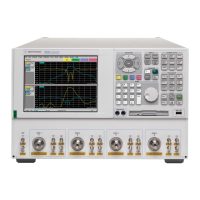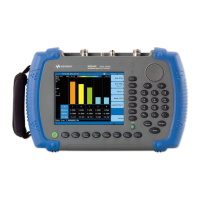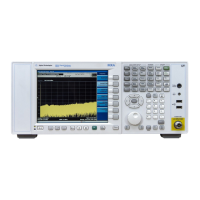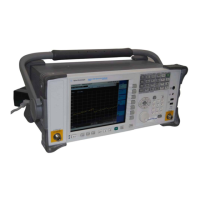Service Guide N5230-90024 3-39
PNA Series Microwave Network Analyzers Tests and Adjustments
N5230C Adjustments
Receiver Calibration Adjustment
The receiver calibration is used to adjust the network analyzer receivers for a flat response across its full
frequency range:
1. A power meter/sensor is connected to Port 1, as shown in Figure 3-17, to establish a reference for
flatness.
2. A cable is inserted between the power sensor and the test port, as shown in Figure 3-18, to establish a
reference for the cable.
3. The same cable is connected between the two test ports, as shown in Figure 3-19, and a signal from Port
1 is used to adjust the “B” receiver at Port 2.
The adjustment is repeated using a signal from Port 2 to adjust the “A” receiver at Port 1.
Data obtained during this adjustment are stored in the mxcalfile_pxx files on the hard disk drive (where xx is
a 1 or 2 digit number). The data are used in subsequent measurements.
If the hard disk drive is replaced, these mxcalfile_pxx files will be lost. Therefore, they should be backed up
(saved on a USB drive) so that they can be restored. If using multiple disk drives (e.g. classified and general
usage), then these files must be replaced on each individual disk drive.
These files can be recreated by performing another receiver calibration adjustment.
Equipment Used for the Receiver Calibration Adjustment
Procedure
1. Connect the equipment as shown in Figure 3-17. Connect a GPIB cable between the network analyzer
and the power meter.
Equipment Type
Models
Used With
Model or
Part Number
Alternate Model
Part Number
Power meter All E4418B/E4419B E4418A/E4419A
Power sensor, 3.5 mm 20 GHz models E4413A 8485A
Adapter, 3.5 mm (f) to 3.5 mm (f) 20 GHz models 83059B 85052-60012
RF Cable, 3.5 mm (f) to 3.5 mm (f) 20 GHz models 85131C 85131E
Power sensor, 2.4 mm 40 and 50 GHz models 8487A None
Adapter, 2.4 mm (f) to 2.4 mm (f) 40 and 50 GHz models 11900B 85056-60007
RF Cable, 2.4 mm (f) to 2.4 mm (f) 40 and 50 GHz models 85133C 85133E

